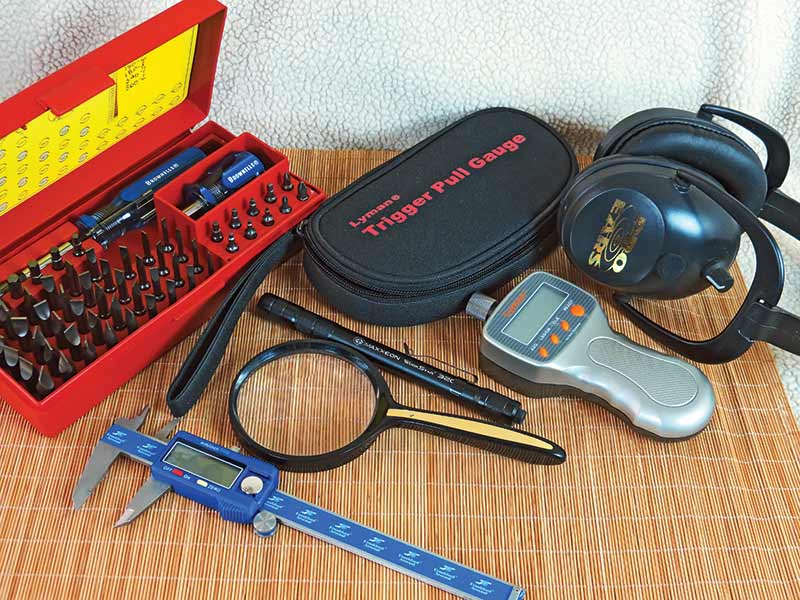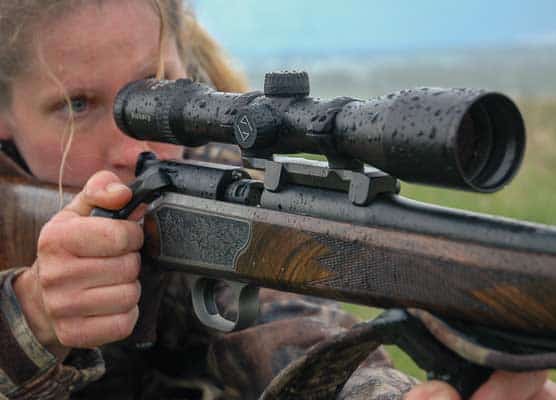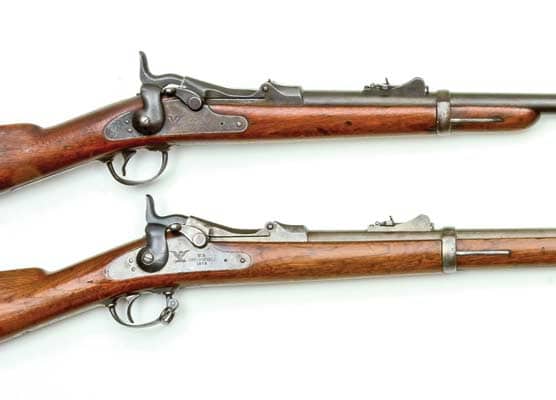What’s This “T&E”
Business, Anyway?
How the Pros Don’t Do It
A rare moment of quiet in the shop: I was sittin’ at the island workbench with electronic range muffs on; the left muff turned to max and volume on the right turned off; holding a pistol by the left side of my head and slowly strokin’ the trigger when our youngest crew member Robbie appeared at the hatch. His eyes popped like saucers and it looked like he gulped a golf ball.
“Sir?” he stammered, “Uhhh… What the heck are you doin’?”
I put the pistol down and waved him in. Told him I was listening to a trigger; doing T&E work. Then I realized it must have looked pretty strange. I laughed and asked him what he thought was happening. He loosened up and gave a goofy grin.
“Well,” he said, “It kinda looked like you were gonna blow your brains out, but maybe you didn’t want the noise to hurt your ears. I thought, Wow, that’s really messed up—and weird, sir.” That cracked me up…
So, we talked about my Test & Evaluation procedures. He said he’d read several T&Es and never heard of anyone using amplified muffs to listen to a trigger — and asked if “all the pro gun writers do that?”
First, I explained, amplified hearing can clarify what your finger may feel as a glitch or rough spot in a trigger pull. I wanna know what and where it is. If you’ve got noise, unusual stacking and a gritty feeling, that can signal a problem that isn’t in the design, but in that trigger in that gun — or, a serious manufacturing problem. I do the same thing with slide travel on auto pistols and cylinder rotation in revolvers, listening while slowly cycling the action and feeling variations in friction and tension. I use amplified muffs because my hearing is degraded from gunfire and ordnance, my left ear being less damaged than my right. Turning off the right muff blocks ambient sound interference from that side.
As for the second question about “what professional gunwriters do,” I confessed — I don’t know, because I ain’t one. I’m not a gunsmith either; not even a good gun mechanic. I’m just an itinerant weapons operator who talks to folks on paper, and fell into firearms T&Es the same way some people get hit by busses: You’re on your way somewhere else — and then you’re not. Until I got hit by the gunwriting bus, most of my experience had been like, (1) Receive issued weapon. (2) Assure it works sorta-OK. (3) Use it, abuse it, do reasonable preventive maintenance. (4) If it breaks or malf’s, especially at one of those “very, very wrong moments,” fling it aside and grab another weapon. I’ve had to develop my own protocols to keep my editors from learning the extent of what I don’t know.
So, I can’t tell you what professionals do, but I can share a few selected things I do. Who knows? It could interest you.
Before Live Fire
Note for nit-pickin’ Safety Nazis: For what follows, presume weapons are triple-checked at every stage for the presence of any form of ammunition; that all ammo is stored at least two counties away in a guarded bunker with a gigantic child-proof cap. That’s not true, but presume it. Thank you.
The first thing I do with any firearm is grip it, heft it, repeatedly swing and point it. Holding it at “low ready” I focus on an aiming point at a distance, close my eyes, present the weapon, then open my eyes and see how close—or how far off—my “natural point” is. Sometimes it’s not so hot. In that case I ask other folks to try it, and consider the results. This is one of many things I do in T&E that don’t often see print because “if it’s not remarkable, positive or negative, there ain’t room to remark on it.”
I check all safety systems, first, to make sure they actually work. Sometimes they don’t. If they do, I try to spoof ’em, mess with ’em and see if I can induce failure through simple but moron-creative mishandling. I figure if there’s a weak point, somebody’s gonna find it, so I should report it. I also attempt to “bump off” weapons on safe, because again, if it can happen, it will. If I write that firing Firearm X requires a proper, deliberate pull, you can bet I’ve tested it, meaning I found that firearm operates within reasonable standards, period. As with anything mechanical, “your results may vary.”
With defensive pistols, I check to see how much pressure at the muzzle end—as if pressing against somebody’s belly—may take the action out of battery enough to render the piece inoperable. Sometimes it only takes very light pressure. If you may carry that piece into a fight, I figure you should know about that.
I break out lights and magnifiers to check things like the firing pin nose and extractor—then check again after test-firing is completed. It’s important to check both the face and claw of extractors for even minor damage after as few as several hundred rounds. All anticipated wear, bash and chatter points are checked too, before and after. Checking muzzle crowns can reveal nasty surprises. Twice I’ve found serious, accuracy-killing damage, presumably from factory accidents. Triggers are not just weighed before and after—they often improve with break-in—but also, throughout arc of movement, triggers and hammers are checked for lateral wobble—a bad sign. Check what happens when you short-stroke a trigger too; see if the action binds up. Check consistency of re-set.
New from the factory, lube can be hit-or-miss, usually on the dry side, and usually, affecting small action and trigger system parts. Extensive firing without proper lube can accelerate wear which can’t be cured with lubing later, so don’t get overeager and just lube rails before hitting the range.
I try to stick with the same soup used by the maker, if known. For example, SIG SAUER uses Mil-Comm products and Kahr uses Militec-1, both excellent goops. If the sauce is unknown or generic, I clean the piece thoroughly and apply a known winner, like SLiP 2000 EWL. Remember, some lubes do not play well with non-family members.
On The Firing Line
You may not read it, but I fire every semi-auto angled from 12, 3, 6 and 9 o’clock, and fore-and-aft, as close as possible to straight up and straight down. If they choke, that’s important. I pay a lot of attention to ejection; where brass is thrown, with what alacrity, at what angle — and how consistent it is with each type of ammo, because different loads and slug weights will “throw” differently. It’s a good “general health” clue. Note that initially, some pistols that fling brass in your face will settle out to 4 or 5 o’clock with break-in. If you have one load, which throws “consistently inconsistently,” chrono results may show a wide Extreme Spread in velocity, and there’s your answer.
Expended brass is checked for consistency of firing pin indent position and depth; primers for backing out; case mouths for splits; extractor grooves for gouging and tearing … all bad signs.
When shooting groups to determine inherent accuracy, I’ll often use some form of rest for stability, but never a machine rest like a Ransom unit. I want results which you folks can replicate. It’s both satisfying and frustrating when I T&E a gun that will clearly shoot straighter than I can hold it. With pure fighting guns, it’s their behavior in simulated gunfighting use that counts with me, so that’s what I emphasize in reviews.
Hey! I said “a few selected things” and I’ve still got three pages of notes! But if one thing you’ve read might save you time, money, grief — or maybe your life — I’ve done my job. Woof-woof!
Connor OUT.



